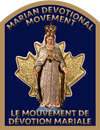November 8: OUR LADY OF FAIR MOUNTAIN
Men called them the “shining hills.” Their white tops glistened against the western sky like some lovely mirage that beckoned to the land beyond. One man, the giant Pere De Smet, had put into words the exhilaration that others felt in beholding these tremendous rocky hills: “You think you have before you the ruins of a whole world, covered with the eternal snows as with a shroud...” Other men later called them the Rockies.
By these barriers the First Nations tribes west of the mountains were isolated from the certain corruption that followed the white man’s coming. The First Nations here had somehow got a bare inkling of the Truth and sent three delegations to Saint Louis begging for priests. Their hearts were ready. So, on Christmas Eve of 1841, Father De Smet was jubilant. On the coming feast, he would baptize one hundred and fifty neophytes; he had regularized thirty-two marriages in the past weeks. Here in the wilderness was another Bethlehem, where the congregation of St. Mary’s of the Bitterroot would sing hymns in honor of Christ’s nativity and join in the Rosary. It was fitting that Our Lady should come to Bitterroot to smile approval; and she DID come that Christmas night to a little First Nations’ boy named Paul.
He was an orphan and trying to learn his prayers, which he did not know. A few hours before midnight mass, he had gone to the hut of an aged woman, and in his own words, he saw, “Someone very beautiful. Her feet did not touch the earth; her garments were white as snow; she had a star over her head, a serpent under her feet and a fruit which I could not recognize. I could see her heart from which rays of light burnt forth and shone upon me. When I first beheld all this, I was frightened, afterward my fear left me, my heart was warmed, my mind was clear, and—I do not know how it happened—but all at once, I knew my prayers.” He ended by saying that she had appeared several times in his dream and told him she was pleased that the first village of the Flatheads should be called St. Mary’s.
Father De Smet wrote his accounts in French and just lately have they been translated. When the Oregon country was opened, some writers dismissed this casually with, “Some of the First Nations even fancied they had visions of the Virgin Mary.” Was this perhaps the first modern version of the Immaculate Heart? We would like to know more; because more than a century ago, Father De Smet began his work at Bitterroot by consecrating the First Nations to the Immaculate Heart. He adds in his records that he did not doubt the child’s words, since he was good. Next year, 1842, the month of Mary was kept. At the end, a statue of the Virgin was borne in triumph to the place of the apparition, since that day he continues, “A sort of pilgrimage was established under the name of Our Lady of Prayer.”
Little Paul died from eating some poisonous herbs. His death occurred on the eve of disaster for the First Nations, when the white men moved into the valley. For a land so blessed by Our Lady, we have been strangely unresponsive to her. How badly we today need Our Lady of Prayer—if she came to us now, would she smile on America?
From the Woman in Orbit - A Timeless Marian Treasure Compiled By Sr. Manetta Lamberty, S.C.C.
Apparition Evangelization - start your journey today with a FREE Marian Consecration ebook HERE
The Memorare and the Angelus HERE
Do you pray the Rosary? For the most powerful way to pray, click HERE
2033: Hope, Meaning and Purpose Video
A priest discovers a pig chewing on a Rosary. What he does next transforms his dying parish into a National Shrine!
WATCH BRIDGE OF ROSES ONLINE WITH UNLIMITED STREAMING ON VIMEO HERE
RENT OR PURCHASE BRIDGE OF ROSES ON MDMTV HERE
BUY BRIDGE OF ROSES DVD HERE
Mary's Love Letter - HERE
The story behind the reprinting of the Woman in Orbit HERE
The Woman in Orbit - Mary’s Feasts Every Day Everywhere HERE


